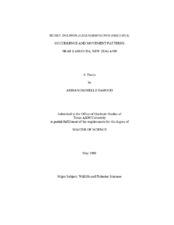| dc.description.abstract | In Kaikoura, New Zealand dusky dolphins (Lagenorhynchus obscurus) are
economically and ecologically important. However, more information on key habitat
requirements is needed to develop an effective management plan for them. I use
systematic shore-based observations and tour operator gathered boat-based observations
and review night-time foraging observations to explore dusky dolphin occurrence and
movement patterns. I discuss possible influence of prey on these patterns. From
January to December 2006, I conducted crepuscular observations from three clifftop
stations. With these geospatial data I examined occurrence, mean speed, and linearity
over seasonal, diel, and tidal temporal scales. From October 1995 to November 2006
tour guides recorded GPS locations for over 5,000 dusky dolphin groups, allowing me to
examine seasonal occurrence patterns. For both datasets I quantified occurrence patterns
relative to depth, distance from the Kaikoura Canyon, and distance from shore. I
reviewed the three studies conducted on dusky night foraging behavior in Kaikoura. I
explore the effects of seasonal and lunar-scale changes in night-time light levels on
dusky dolphin foraging behavior. Duskies exhibited seasonal and diel, but not tidal occurrence and movement
patterns. Dolphins were found farther offshore, in deeper water, and travelling faster in
winter and approaching sunset. The areas of highest sightings density were associated
with the Kaikoura Canyon, and shifted almost entirely into the canyon in winter and
approaching sunset. Dolphins made sharper turns during summer. Dolphins were, on
average, closer to the Kaikoura Canyon than to shore. Seasonal occurrence patterns
described by tour operator data agreed with those described by geospatial data collected
by shorebased observers. Duskies exhibited flexible foraging behavior and appeared to
use both seasonal and lunar phase specific tactics. Night-time light levels appeared to
influence dusky foraging behavior, possibly through changes in prey behavior. Prey
availability and behavior patterns appeared to influence dusky occurrence and movement
patterns. The dolphins' affinity for the Kaikoura Canyon may reflect a strategy to
maximize access to prey. | en |


